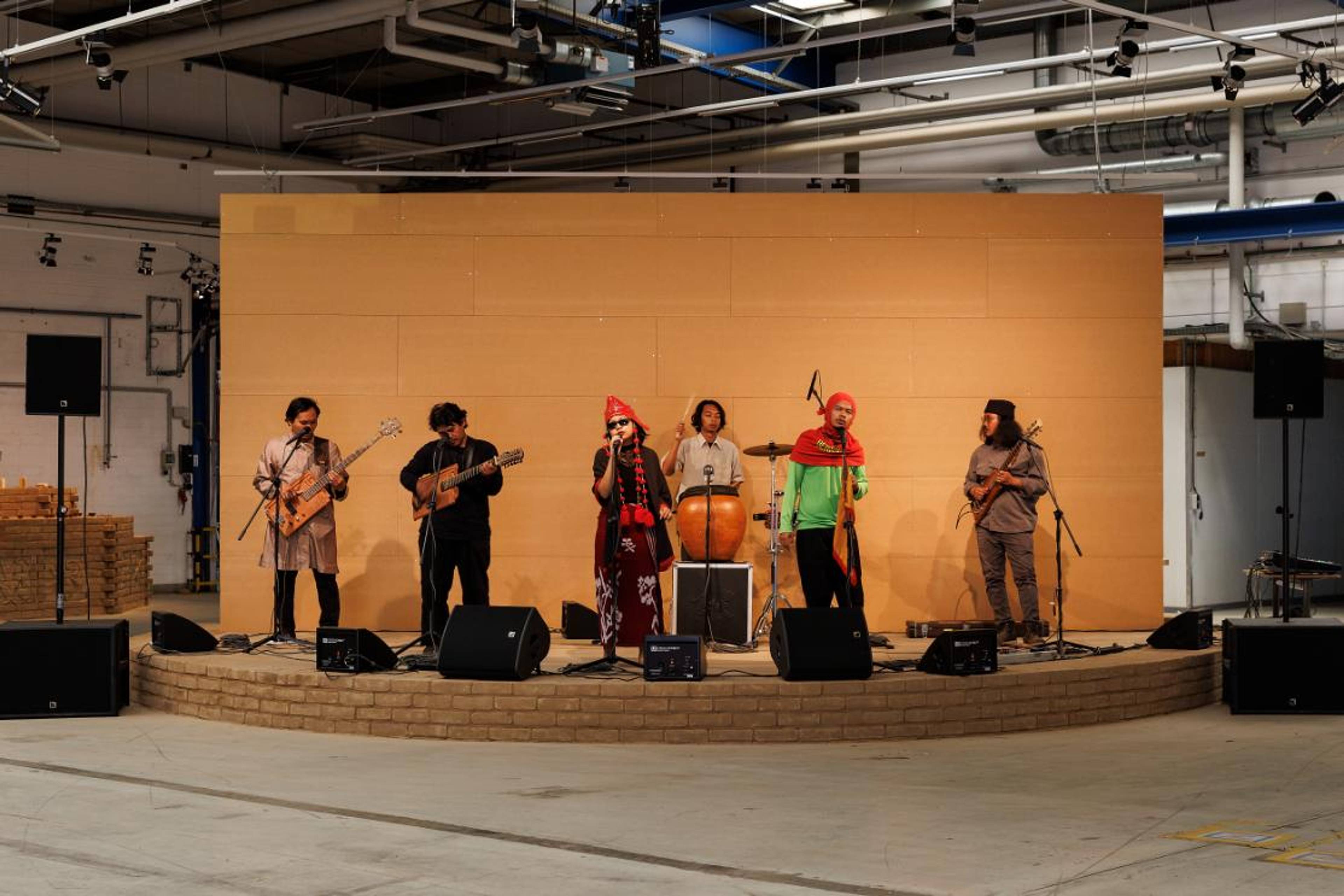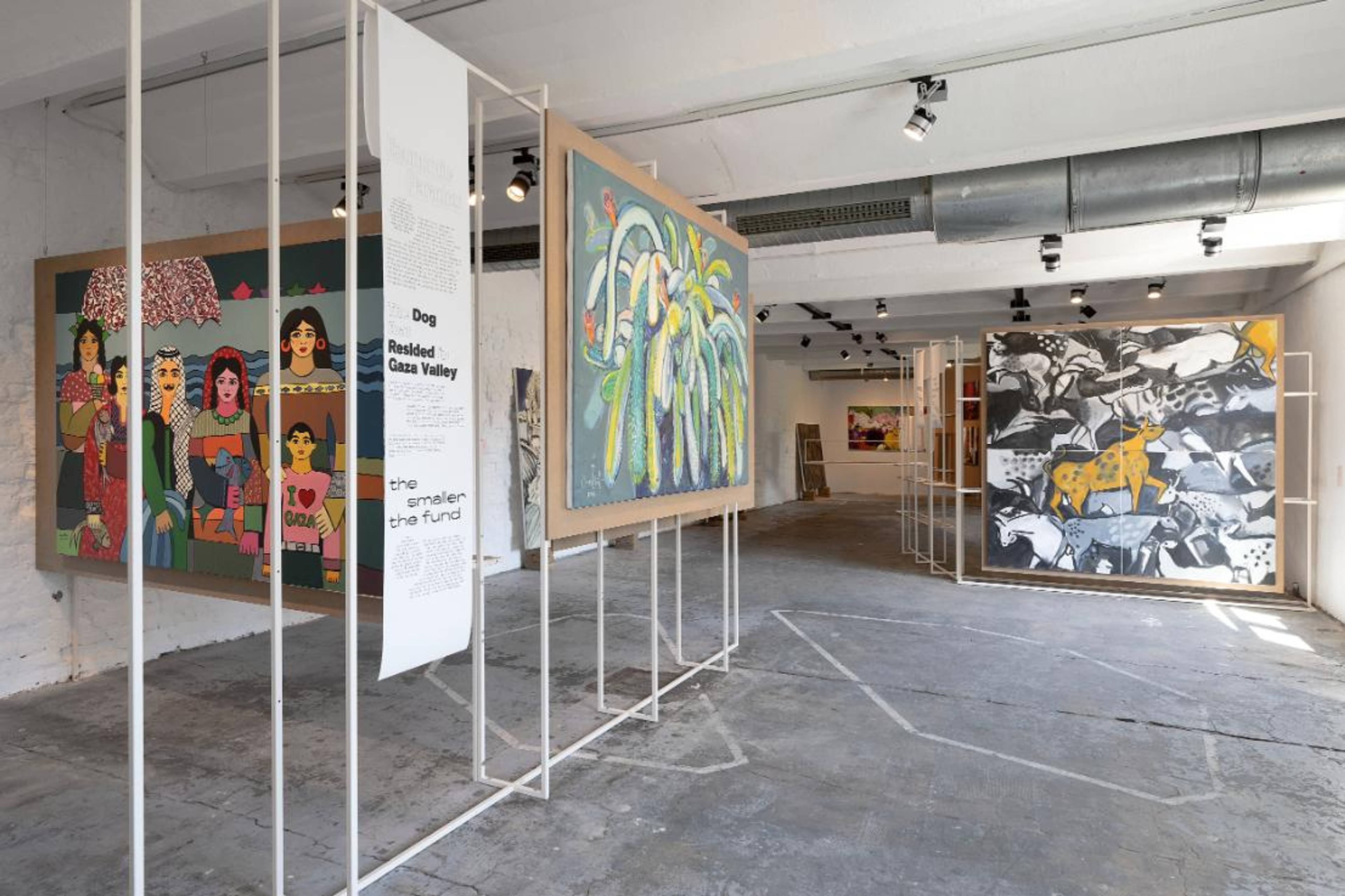SPIKE: After the Taring Padi mural was removed due to calls of antisemitism, bot the artist collective and the exhibition’s curators, ruangrupa, issued statements. What did you make of them?
Andrew Berardini: The statements are sweetly ineffectual. But that’s what I felt about most of this documenta.
And with a dozen plus curators, I still find it curious that nobody actually looked at this giant central billboard of an artwork in the heart of Friedrichsplatz. A decentralized curatorial structure clearly leads to a lack of quality control. I’m sure Taring Padi does meaningful political protest in Indonesia, but for me, they made a glut of ugly cardboard political posters in Kassel. I couldn’t connect to their struggle through their artwork. This is perhaps a failure of empathy on my part, or it could be that it’s just bad art. Maybe both even.
Necessary, well-meaning, heartfelt social and political practices don’t necessarily make for good art. Or they didn’t here for me. If Taring Padi does an exhibition in my hometown, I don’t believe I’d rush to see it.
Nathalie von Veh: I think the statements are pretty effective, and again, I really appreciate that they’ve incorporated this into their timeline and been transparent. While the Taring Padi piece should have never been installed, I also think that this shouldn’t cloud all of the other artists’ work or make us question the importance of such collective work. I really appreciate Siddhartha Mitter’s perspective here.
How can you blame ruangrupa, when so much right-wing bad faith and slander has been thrown their way ever since their appointment?
foundationClass*collective. Installation view, documenta fifteen, Kassel, 2022. Photo: Maja Wirkus.
Edwin Nasr: I agree with Andrew that both these statements are “ineffectual,” and if we are to sit with the former, we could read and discern a generalized exhaustion between the lines. I would even say that, through this statement, ruangrupa aren’t repenting – which, to be clear, they shouldn’t – so much as they’re showing signs of resignation. How can you blame them, when so much right-wing bad faith and slander has been thrown their way ever since their appointment? They’re exhausted, overworked, unwelcomed, dismissed. Having said that, I would much prefer to sit with and think about the plethora of “statements” and commentaries the documenta administration itself as well as predominantly white European actors in the cultural sector shared in the wake of the scandal.
There has been a vested and sometimes useful interest in assessing whether or not the now removed mural indeed contained antisemitic depictions and, if so, why (see: Eyal Weizman & A. Dirk Moses). Unfortunately, others went so far as to assign themselves an “inspectorial” role: Take, for example, the article in Monopol magazine that effectively triggered the scandal, where the writer admits that herself and colleagues were going through the exhibition “like detectives” looking for “traces of antisemitism” [quotes translated from German], or Jörg Heiser’s review for art agenda, which is an otherwise okay take, but at times bewilderingly doubles as a police report-style enumeration of featured artworks he thought were antisemitic. I mean, what’s with the paranoid rhetoric?
There were also those consistently cheering from the sidelines as ruangrupa got appointed but who swiftly deemed it a moral imperative of the highest order to publicly, and self-righteously, express their “disappointment” and perform “outrage” as the Taring Padi scandal unfolded, all the while resorting to patronizing and often racist rhetoric to explain their shared indignation (“They [ruangrupa] don’t know any better but should have,” “they’re naïve,” etc.). I found these statements quite telling of their authors’ intentions, but also of their functional – and in some cases, desired – roles as gatekeepers of the white European artistic establishment. To me, this “disappointment” indicates that those who are most visible in distributing care and solidarity often have it filtered through a set of conditional parameters that ensure their own professional survival and will throw under the bus those they had previously insistently framed as allies whenever faced with a faint smell of friction or potential miscomprehension. I kept thinking of that viral video of Tyra Banks abusively screaming “WE WERE ALL ROOTING FOR YOU” at an exhausted America’s Next Top Model contestant disrespecting her authority throughout the unfolding of that ordeal.
And then when Hito Steyerl threw her confusing withdrawal into the mix, it became important to remember that none of the mentioned parties so much as uttered a word when participating artists and members of the curatorial team from Palestine were the target of anonymous death threats and smear campaigns by Kassel-based, Antideutsche sympathizers to the complete disregard of the documenta administration, whose own statements were at best evasive, and at worst obfuscating. I mean, even Meron Mendel, director of the Anne Frank Educational Center, accused them of exhibiting a “neocolonial attitude” towards ruangrupa.
The Nest Collective, Return to Sender, 2022. Installation view, documenta fifteen, Kassel. Photo: Nils Klinger.
Mohammad Salemy: It is astonishing that, as far as I can remember, nobody has compared the removal of Taring Padi’s mural with the designation and destruction of modernist art by Nazis in the 1930s as “degenerate art.” As I explained in my piece for the Arts of the Working Class, the bigger problem than the antisemitic content found in the exhibition is this Documenta’s adherence to decentralized planning — something that European cultural policymakers in the early 2000s decade had already identified as their preferential model of art and cultural production and distribution. ruangrupa has been groomed to employ this method for many years by European funding agencies, particularly Hivos and other Dutch bodies, through direct funding and benign awards to implement exhibitions in Europe.
If the risky experiment of curatorial ineptitude was a chosen methodology for this edition of documenta, the curators don't even seem to know the first rule of contemporary art that artists learn in art school: if you made a mistake and got caught, you have to claim that it was part of the work. Even if we suspect that Taring Padi might have been aware of the risks involved in showing the mural in Germany, we have to assume that the curators did not intentionally include this work to provoke German sensitivities. But upon their discovery, they should have made the argument that this kind of friction is what the decentralized curation strives to create. Instead of any kind of apology, rad or soft, which ultimately made German history and sensitivity the central ethical concern of documenta should have insisted on the work remaining in the show. They should have reminded Germans who had selected them to curate this edition that this is exactly what one might hope to get a decentralized exhibition without a grand curauteur (auteur as in modernist European cinema, authoritarian-curator) and a centralized model of planning.
Why claim to make an anticolonial exhibition, if you are not able to stand by your method of curation and the kind of tensions it might create in the larger social world?
In light of the violence and attacks that had already taken place against the Palestinian collective The Question of Funding prior to the exhibition opening, they should have made an issue out of historical and political discrimination and threatened to resign and close the whole show if the work was going to be brought down. Otherwise, why claim to make an anticolonial exhibition, if you are not able to stand by your method of curation and the kind of tensions it might create in the larger social world?
Instead, they allow for a precedent to be set: a decolonial exhibition paid by Europeans will ultimately will be vetoed according to their sensitivities and ethical priorities and cannot be claimed as a novel exercise of decentralized curation when Big Brother can intervene anytime and do the necessary exclusion based on ideas emanating not from the colonial peripheries but from the very center that has been put on display as the object of critique. If anything, the antisemitism controversy at documenta might have proven that there is a transparent or black boxed power relation behind the performance of decentralization that can shamelessly intervene in the decolonial interface if necessary and insert is centralized and Eurocentric values straight into the otherwise counter-cultural exercise by peripheral curators and artists.
Music Group, Lair, 2022. Performance view, documenta fifteen, Kassel, 2022. Photo: Frank Sperling.
SPIKE: In documenta fifteen, the collective *foundationClass hung a banner that reads, “My biography seems more interesting than my art.” What do you think of the recent discourse around art as social practice?
AB: If you can’t be good, at least you can be honest.
There’s a lot to unpack in that declaration. From tokenizing identity to “interesting” being a marker of value, but the question above is about the “recent discourse around art as a social practice.”
I take umbrage with the word discourse as framing a conversation with a specific academic language which I often reject. Theoreticians and academics too often claim primacy in any discussion around art by dictating the terms of the discussion. But I think part of the conversation here is about terms. Many of my colleagues complained that there was very little “art” in this documenta. It’s a little retrograde as a statement, but I know what they meant. And I truly defend all the participants who call themselves artists in this documenta to absolutely be artists making art.
Robert Rauschenberg was once invited to contribute to an exhibition of portraits of the iconic French gallerist Iris Clert. Busy installing a show elsewhere, he instead sent them a telegram declaring: “THIS IS A PORTRAIT OF IRIS CLERT IF I SAY SO.” Which is all to say, artists can declare whatever they wish to be art, including social practice. I am ready and open to be moved by any and all of it.
Just too often at this documenta, I wasn’t.
It is reductive for a critic to give a thumbs up or down really to any art show, and I don’t want to do this here. If an operating ethos of documenta 15 was “Make Friends, Not Art” then perhaps they succeeded on their own measures, even if it didn’t succeed for me in what I usually look for in art.
The Question of Funding hosts Eltiqa, 2022. Installation view, documenta fifteen, Kassel, 2022. Photo: Nils Klinger
Övül Ö Durmusoglu: I read the statement as a critique of the Western construction of artistic biography making and made me think of Natascha Sadr Haghighian’s work on fictitious bios as a form of resistance to categorizing information.
The FC Collective has become an important platform for young voices who have arrived in Berlin after leaving their collapsing cities and who haven’t felt welcomed in the city. If I may speak of the German art scene experience from the immigrant’s perspective, the idea that “whether you come from a war zone or not is more important than your artistic practice” contains some truth. The expectation to hear about the conflict and destruction repeatedly drives certain artists to use their identity as cultural capital in order to be included. As far as I have observed, there’s an interesting gap, there is demand and funding for “biography” related works but then those works are not considered as serious enough. Should that lead to a critique in the form of social practice? Yes, why not. Because often social-oriented practices are not seen as art while artists are getting more interested in making things happen than just making things in the face of deepening inequalities and hypocrisies of the world we live in.
EN: I don’t have much to add here that hasn’t already been said much more sharply by Övül. But just to quickly comment on the second part of the question: I don’t think “art as social practice” is a recent formulation nor does it particularly come to describe recently developed artforms. I’ve been in fact wondering whether this edition of documenta would come to trigger a “paradigm shift” in the global art circuit — but the more I think of this, the less convinced I am that it will. There’s something already quite old about its supposed newness. Also, I feel it will be difficult to emulate similar models in the future; documenta fifteen, or the “lumbung one” as ruangrupa calls it, has been fermenting for decades, and is a collective articulation of wide networks of organizational forms born through or in spite of — depending on which we’re talking about — neoliberal economies in the post-conflict developing world. It is less the documenta of “social practices” than it is that of this particular history of institutional arrangements which will continue to prosper but might also, amid our present conjuncture, morph into entirely different entities. Within this heterogeneous and wholly inconsistent thing we call the global art circuit, we have also learned the hard way that several “turns” can unfold at the same time and in synchronicity with each other — yes, this edition of documenta inspires us to do away with the sanctity of the art object and the myth of the individual genius, but around that same time, the Venice Biennale “we” have come to equally celebrate was in fact indistinguishable from an art fair.
MS: It is interesting that the question allocates a work to the category of social practice where in my opinion, if I am not wrong, the statement clearly is a comment on identarian art. And as such, the comment is neither cynical enough to be considered a critique of identarian policies nor critical as to why European institutions have in the last decade increasingly filled their programing with this kind of art. Thus, the piece offends any critical visitor who demands more from artists raising the issue but who refuse to provide an honest answer — instead opting to go for a drink with friends who also have other kinds of interesting biographies that have made them fortunate enough to be included in an international exhibition, talking about the stupidity of guilt-ridden white liberal policymakers who has enabled them to make a shortcut in their career and arrive at documenta without a track record in material practice of making art, only for possessing the right ethnicity or cultural flavor in the right time.
NvV: To me, this banner feels very much like it’s speaking to the white art world, and I think it’s effective and important to be said on such a platform, with so many people coming through documenta who might be encountering collectively based work for the first time.
Más Arte Más Acción (MAMA), Whispers of the Bark Beetles, 2022. Installation view, documenta fifteen, Kassel. Photo: Nils Klinger
___
For educated guesses as to Documenta’s post-ruangrupa future, click through to part three of this roundtable. Or, for an overview of the exhibition’s highs and non-scandalous lows, tab back to part one.







